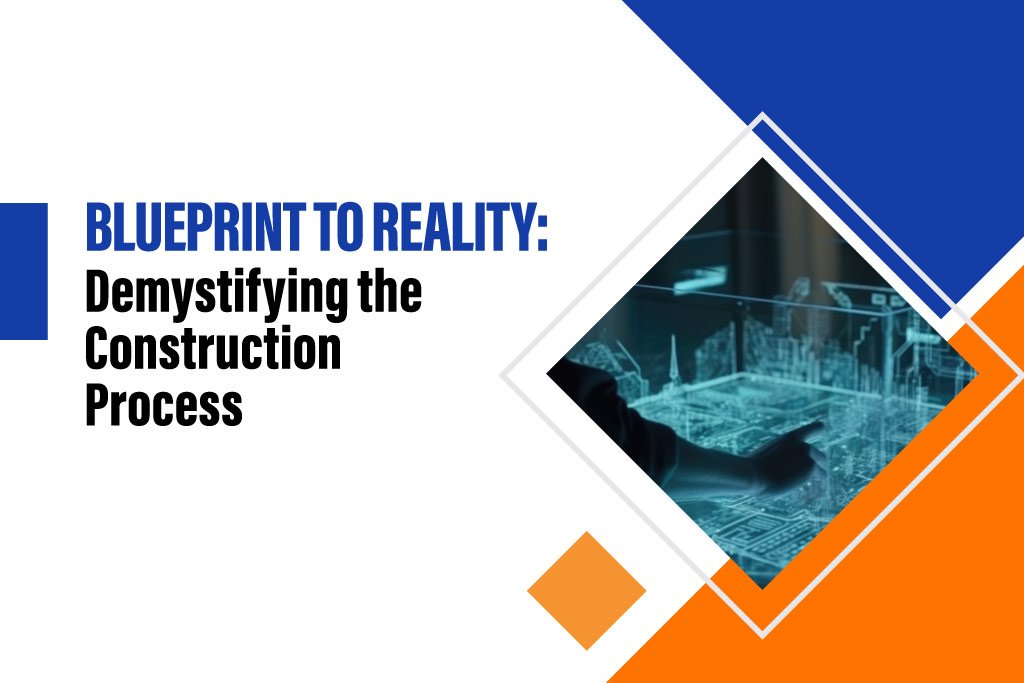
The construction sector, a symphony of engineering precision and architectural vision, brings blueprints to life. We break down the extensive process of construction in this blog, starting with the drawing board to the construction site.
The Blueprint
The blueprint, a carefully crafted document that details every aspect of the construction, is the first step on the route from concept to creation. Loaded with technical expertise, civil engineers work with architects to realize the project’s concept. During this stage, the design is conceptualized while taking local construction regulations, aesthetic appeal, and durability into consideration.
Site Preparation
With the blueprint in hand, the focus switches to the construction site. An essential first stage is site preparation, which entails clearing the area, digging, and laying a level foundation. Every city necessitates special consideration as per the city’s regulations throughout this stage to guarantee stability and efficient utilization of the land.
Foundation Construction
At this point, the foundation, like the spine of a building, begins to take shape. Depending on the project’s requirements and the state of the soil, engineers might select between shallow and deep foundations. The varied soil compositions across various cities present a challenge for engineers, who must use their expertise to choose the best foundation type in order to ensure stability and longevity.
Structural Framing
There is a clear change in direction toward the realization of the structure when the foundation gives way to structural framing. The fundamental structure is constructed carefully, adhering to the specifications on the blueprint, using either steel or reinforced concrete components. It is essential to maintain precision throughout this phase to guarantee the stability and safety of the developing construction.
Shaping the Identity
Installing windows, roofing, and walls determines the building’s individuality and encloses the structure. Top civil engineering colleges in Coimbatore, let the students work on-site in the lively Coimbatore environment which is renowned for its fusion of modernity and tradition. It also has an impact on the architectural finishes and material selection. During this stage, the structure is transformed from a skeletal frame to a recognizable shape.
Mechanical and Electrical Systems Installation
Sophisticated plumbing, electrical, HVAC, and ventilation systems are necessary for modern buildings. At this point, the installation of these systems goes smoothly. With the Best engineering colleges in Coimbatore and as an expanding center of technology, Coimbatore places a strong focus on incorporating eco-friendly and low-energy building methods.
Quality Inspections
Throughout the construction process, quality assurance is crucial at every stage. Strict inspections that comply with regional and federal regulations ensure that the project’s safety procedures are followed. This rigorous inspection ensures that the building follows the blueprint exactly, without compromising quality.
Project Completion
The final stretch involves binding up any unresolved issues, executing final inspections, and securing all necessary approvals. The journey from blueprint to reality is complete when the structure rises to a prominent position.
Tools Used by Civil Engineers in Construction
To ensure that buildings are constructed precisely and efficiently, civil engineers use a wide range of instruments. These instruments improve construction project quality and safety in addition to increasing production. The following are some vital instruments that civil engineers use:
1. Surveying Tools:
Total Station: An electronic optical tool that helps measure distances and angles, which is essential for precise surveying.
Theodolites: An essential tool in land surveying to measure both horizontal and vertical angles.
2. Excavation Tools:
Excavators: During site preparation, these heavy machines are employed to excavate and move massive volumes of earth.
Backhoes: Perfect for modest excavations and trench digging.
3. Concrete Mixers:
Batch Mixers: These machines combine cement, sand, and water to make the concrete needed for different building components.
Continuous Mixers: These machines deliver a consistent flow of mixed concrete, making them perfect for large-scale projects.
4. Concrete vibrators:
Internal vibrators: Used to promote level distribution and remove air bubbles while pouring concrete.
External vibrators: Used to improve consolidation by applying them to the concrete forms’ surface.
5. Cranes:
Tower Cranes: Necessary for raising bulky goods to high altitudes when building.
Mobile Cranes: These cranes are portable and versatile, and they may be utilized for a variety of lifting jobs.
6. Drilling Machines:
Rotating Drills: Used to drill holes in the earth for geological exploration or foundational components.
Hammer drills: Useful for drilling through concrete and other hard materials.
7. Safety Gear:
Hard Hats: : Guard the head against debris and falling items.
Wear high-visibility vests to ensure that you can be seen on crowded building sites.
8. Measuring Tools:
Tape Measures: : These are necessary for precise distance measurements.
Levels: : Used to guarantee alignment both horizontally and vertically.
Accurate distance measurements can be obtained with laser distance meters.
It becomes clear as we work our way through the complexities of the construction process that the instruments used by civil engineers are the paintbrushes with which the architectural vision is painted. Every tool is essential to turning designs into real buildings, from the Tower Crane that lifts materials to dizzying heights to the Total Station that directs the surveying process.
In summary, the construction process is a combination of skill, accuracy, and imagination from the plan to the final construction. The best placement engineering colleges in Coimbatore are knowledge pillars that raise the students who design, plan, and build the wonders that shape our landscapes.
